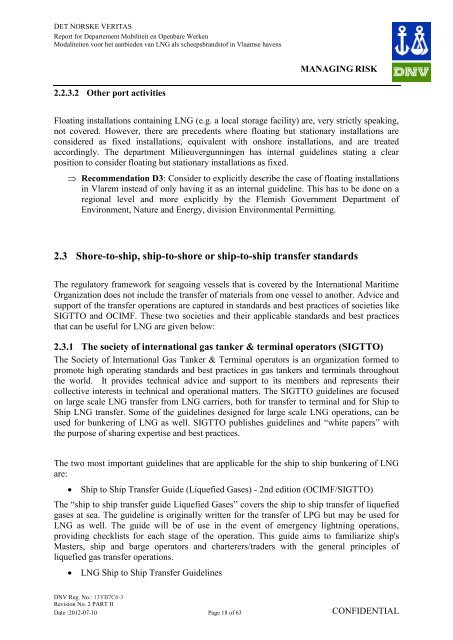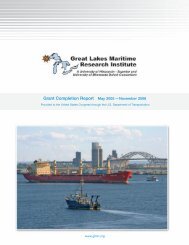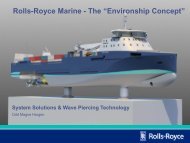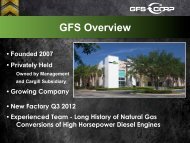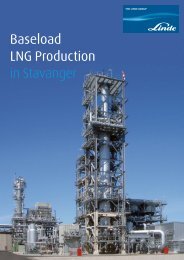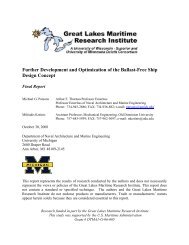Modalities for the provisioning of LNG as shipping fuel in Flemish Ports
Modalities for the provisioning of LNG as shipping fuel in Flemish Ports
Modalities for the provisioning of LNG as shipping fuel in Flemish Ports
You also want an ePaper? Increase the reach of your titles
YUMPU automatically turns print PDFs into web optimized ePapers that Google loves.
DET NORSKE VERITAS<br />
Report <strong>for</strong> Departement Mobiliteit en Openbare Werken<br />
Modaliteiten voor het aanbieden van <strong>LNG</strong> als scheepsbrandst<strong>of</strong> <strong>in</strong> Vlaamse havens<br />
MANAGING RISK<br />
2.2.3.2 O<strong>the</strong>r port activities<br />
Float<strong>in</strong>g <strong>in</strong>stallations conta<strong>in</strong><strong>in</strong>g <strong>LNG</strong> (e.g. a local storage facility) are, very strictly speak<strong>in</strong>g,<br />
not covered. However, <strong>the</strong>re are precedents where float<strong>in</strong>g but stationary <strong>in</strong>stallations are<br />
considered <strong>as</strong> fixed <strong>in</strong>stallations, equivalent with onshore <strong>in</strong>stallations, and are treated<br />
accord<strong>in</strong>gly. The department Milieuvergunn<strong>in</strong>gen h<strong>as</strong> <strong>in</strong>ternal guidel<strong>in</strong>es stat<strong>in</strong>g a clear<br />
position to consider float<strong>in</strong>g but stationary <strong>in</strong>stallations <strong>as</strong> fixed.<br />
Recommendation D3: Consider to explicitly describe <strong>the</strong> c<strong>as</strong>e <strong>of</strong> float<strong>in</strong>g <strong>in</strong>stallations<br />
<strong>in</strong> Vlarem <strong>in</strong>stead <strong>of</strong> only hav<strong>in</strong>g it <strong>as</strong> an <strong>in</strong>ternal guidel<strong>in</strong>e. This h<strong>as</strong> to be done on a<br />
regional level and more explicitly by <strong>the</strong> <strong>Flemish</strong> Government Department <strong>of</strong><br />
Environment, Nature and Energy, division Environmental Permitt<strong>in</strong>g.<br />
2.3 Shore-to-ship, ship-to-shore or ship-to-ship transfer standards<br />
The regulatory framework <strong>for</strong> seago<strong>in</strong>g vessels that is covered by <strong>the</strong> International Maritime<br />
Organization does not <strong>in</strong>clude <strong>the</strong> transfer <strong>of</strong> materials from one vessel to ano<strong>the</strong>r. Advice and<br />
support <strong>of</strong> <strong>the</strong> transfer operations are captured <strong>in</strong> standards and best practices <strong>of</strong> societies like<br />
SIGTTO and OCIMF. These two societies and <strong>the</strong>ir applicable standards and best practices<br />
that can be useful <strong>for</strong> <strong>LNG</strong> are given below:<br />
2.3.1 The society <strong>of</strong> <strong>in</strong>ternational g<strong>as</strong> tanker & term<strong>in</strong>al operators (SIGTTO)<br />
The Society <strong>of</strong> International G<strong>as</strong> Tanker & Term<strong>in</strong>al operators is an organization <strong>for</strong>med to<br />
promote high operat<strong>in</strong>g standards and best practices <strong>in</strong> g<strong>as</strong> tankers and term<strong>in</strong>als throughout<br />
<strong>the</strong> world. It provides technical advice and support to its members and represents <strong>the</strong>ir<br />
collective <strong>in</strong>terests <strong>in</strong> technical and operational matters. The SIGTTO guidel<strong>in</strong>es are focused<br />
on large scale <strong>LNG</strong> transfer from <strong>LNG</strong> carriers, both <strong>for</strong> transfer to term<strong>in</strong>al and <strong>for</strong> Ship to<br />
Ship <strong>LNG</strong> transfer. Some <strong>of</strong> <strong>the</strong> guidel<strong>in</strong>es designed <strong>for</strong> large scale <strong>LNG</strong> operations, can be<br />
used <strong>for</strong> bunker<strong>in</strong>g <strong>of</strong> <strong>LNG</strong> <strong>as</strong> well. SIGTTO publishes guidel<strong>in</strong>es and “white papers” with<br />
<strong>the</strong> purpose <strong>of</strong> shar<strong>in</strong>g expertise and best practices.<br />
The two most important guidel<strong>in</strong>es that are applicable <strong>for</strong> <strong>the</strong> ship to ship bunker<strong>in</strong>g <strong>of</strong> <strong>LNG</strong><br />
are:<br />
Ship to Ship Transfer Guide (Liquefied G<strong>as</strong>es) - 2nd edition (OCIMF/SIGTTO)<br />
The “ship to ship transfer guide Liquefied G<strong>as</strong>es” covers <strong>the</strong> ship to ship transfer <strong>of</strong> liquefied<br />
g<strong>as</strong>es at sea. The guidel<strong>in</strong>e is orig<strong>in</strong>ally written <strong>for</strong> <strong>the</strong> transfer <strong>of</strong> LPG but may be used <strong>for</strong><br />
<strong>LNG</strong> <strong>as</strong> well. The guide will be <strong>of</strong> use <strong>in</strong> <strong>the</strong> event <strong>of</strong> emergency lightn<strong>in</strong>g operations,<br />
provid<strong>in</strong>g checklists <strong>for</strong> each stage <strong>of</strong> <strong>the</strong> operation. This guide aims to familiarize ship's<br />
M<strong>as</strong>ters, ship and barge operators and charterers/traders with <strong>the</strong> general pr<strong>in</strong>ciples <strong>of</strong><br />
liquefied g<strong>as</strong> transfer operations.<br />
<strong>LNG</strong> Ship to Ship Transfer Guidel<strong>in</strong>es<br />
DNV Reg. No.: 13YB7C6-3<br />
Revision No. 2 PART II<br />
Date :2012-07-10 Page 18 <strong>of</strong> 63 CONFIDENTIAL


